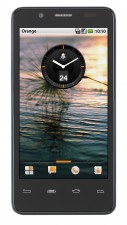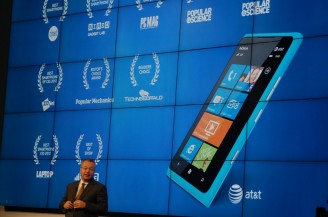(iTers News) – MWC, or Mobile World Congress 2012 kicks off today here in Barcelona, Spain, throwing the long-term prospects of global smartphone markets into question. As a growing list of mobile phone makers as well as no-name low-cost “me too” clone makers in emerging markets are feverishly racing to jump onto the smartphone bandwagon, worldwide smartphone markets will be soon flooded with a deluge of iPhone-like smartphones.
The prevalence of smartphones, especially low-cost model is an ominous portent that smartphones will be a low-margin commodity product, soon, threatening to squeeze out smartphone makers’ profitability.
The faster-than-expected commodification of smartphones bode ill for the final health of service carriers, too, because it simultaneously offers both opportunities and challenges, too.
Pressured by explosion in data traffic that is driven by rapid penetration of smartphones, service carriers around the globe are struggling to raise funds to finance their heavy capital investment to build a next generation of LTE network. Yet, heavy data traffic also can open up new market opportunities.
“Smartphones represent only 12% of total global handsets in use today, but they account for 80% total global data traffic. Each smartphone generates 150 megabytes per month. Yet, data usage on smartphone will hit 2GB alongside increasing penetration of smartphones. It is estimated that global data traffic will increase 18 folds over the next five years. We expect 353 million LTE connections worldwide by 2015, “ said Franco Bernabe Chairman of GSMA and CEO with Telecom Italia Group.
Added he, “This explosion of data needs to be supported by network operators’ investments in network infrastructure as well as their heavy burden of additional investments in such as frequency licensing and device subsidies. Over the next four years between 2012 and 2015, mobile industry will invest almost more than 180 billion (Euros) in capital.”
On the other hand, according to him, mobile operators are experiencing slowdown in revenues, because of stringent regulation and increasing competition, and challenging economic environment. As a result, average monthly revenue per use, or monthly ARPS declined from 26 Euros in 2006 to 20 Euros in 2011.
More spending, less take-in
“What this say about that the industry is still growing, and has lots of opportunities, but challenges we need to face,” he stressed.
Signs of imminent commodification are plentiful across all show floors at MWC 2012 that runs through March 1. The likes of low-cost Chinese mobile phone makers –ZTE, Huawei, and Lenovo – are all showing off their latest smartphone models. Having stayed on the sideline for years, Sony Corp. and Nokia also joined the frenzy, releasing a range of smartphone models from high-end to low-end.
Leading the democratization of smartphones is seemingly microprocessor chip giant Intel Corp., which have been struggling to expand its Atom processor-centric manufacturing ecosystem for smartphones to regain lost growth momentum to ARM process core camp.
Less than 2 months after the chip giant added Lenovo and Motorola Mobility to its ecosystem map, Intel today announced at a press conference held here in Barcelona that mobile service carrier Orange, Lava of India and ZTE of China joined forces with Intel to build their smartphones around Intel’s Atom processor codednamed Medfield.
Less than US$ 100 smartphones
The 32nm Atom processor supports multiple OS platform like Android, Apple iOS and MS Windows Phone.
Lava is an Indian mobile phone maker founded in 2009, and plans to release its 1.6 GHz Atom-based smartphone codenamed X900 in the weeks to come. ZTE of China is also scheduled to ship Atom processor-based smartphones in the 2ndhalf of this year.
The codename Medfield Z2460 Atom processor support 8mega pixel cameras and 1080 p full HD resolution, allowing people to take 10 picture in a matter of less than one second.
To expand its ecosystem from high-end to low-end, Intel plans to debut 22nm Atom processor in 2013 and 14nm equivalent in 2014, said Paul Otellini CEO with Intel at the press conference.
To accelerate the penetration of smartphones into emerging market , Intel is even looking to cheap labor mobile phone makers to build ultra low-cost smartphones of less than US$100 non-subsidized price scheme around its low-cost 1.0GHz Z2000 Atom processor
“The rapid penetration of smartphones would benefit consumers as well as application developers, “ emphasized CEO Paul Otellini.
Yet, that won’t do any good for smartphone makers. According to Intel’s technology roadmap, Intel plans to introduce new generation of Atom processor every year, one year, or 8 months ahead of Intel co-founder Gordon Moore’s observation- Moore’s Law –which has not only brought lots of innovation into PC industry, but also sped up the commodification of PCs, having bred lots of low-cost clones. The commodification has made PC manufacturing low-margin business, forcing PC makers to eke out marginal profits.
The same will be likely to happen in smartphone markets, again.
Here are smartphone models on display at MWC 2012.
Huawei turns aggressive
Huawei has unveiled its Ascend D series smartphones, its new premium handset line, as it set aggressive sales targets for fiscal 2012.
The company debuted two smartphine models with quad-core processors, the Ascend D quad and D quad XL, which are powered by 1.2GHz and 1.5GHz applications processor chips, respectively.
At the company’s launch event, Richard Yu, chairman of Huawei Device, said its quadcore smartphones significantly outperformed a quadcore tablet that is already available, which is significant because it is powered by the same Nvidia processor which is now making its way into the smartphone space.
Yu revealed that the company is looking to ship 60 million smartphones in 2012, up from 20 million in 2011. Much of the volume will be achieved in the Chinese market, where customers are shifting to smartphones from feature phones, aided by aggressive operator subsidies.
The executive said that having previously built its position with low-cost devices, Huawei sees technology leadership as important for the future. “We want the best performance in the industry, because our brand is not that famous,” he said.
Yu said the company is already in talks with tier-one operators about D quad availability, and that pricing will be “competitive” when compared to similar products from rivals. Global availability is scheduled in the second quarter of 2012.
Yu closed the event by revealing that Huawei is readying a tablet device with full HD resolution and quad-core processor, which will be “not lower than the iPad 3.” This device will also include LTE connectivity.
HTC on the road to recovery
HTC announced its One smartphone portfolio, refreshing its premium line with a trio of Android 4.0 (Ice Cream Sandwich) powered devices. HTC is trying to rev up growth engine again after it suffered a tough fourth quarter, as its current handset portfolio shows signs of age.
According to HTC, the One range is intended to be “the one phone you need, but in three different sizes. The largest device is the One X, which has a 4.7-inch screen, and is powered by a 1.5GHz quad-core Nvidia processor. In-between model is the One S, which has a 4.3-inch screen and is powered by a 1.2GHz dual-core processor.
The smallest device is the One V, which has a 3.7-inch screen, with a 1GHz processor.
Across the board, what those devices have in common is cameras with F2.0 aperture, which is larger than that used in competitive devices. This enables more light to reach the sensor – speeding reaction times and improving low-light performance.
This is supplemented by an HTC-developed imaging chip, which enables the manipulation of images before they are saved to common file formats.
The One X and One S both have 8MP cameras, while the One V has a 5MP camera.
The range also includes further integration of technology from HTC’s strategic partner Beats Audio.
HTC trumpeted integration with cloud content services, for example with Dropbox support integrated across the device. The company has not confirmed availability details as yet, but is looking to a multi-territory rollout within 60 days of Mobile World Congress.
Orange makes 20% of its portfolio in-house
Mobile service carrier Orange plans to launch a new high-performance Android smartphone in Europe this summer. Powered by Intel® technology, the device currently codenamed „Orange Santa Clara,‟ will deliver the latest in smartphone capabilities and rich entertainment experiences to more customers.
The phone will first be available exclusively to Orange customers in the UK and France, where its commercial name will be unveiled at launch.
The launch of this smartphone marks a significant development in Orange‟s long-standing and successful strategy to deliver phones under its own brand. Now in its tenth year, it has helped drive new device partnerships and support Orange‟s customer and mobile multimedia growth by introducing more affordable feature phones and smartphones to its whole customer base.
These phones are differentiated by being customised with simple and relevant Orange applications and services. Customer demand has led to the doubling of Orange‟s own-branded portfolio in 2011, increasing volume from 7 per cent to 15 per cent of its total device portfolio.
Orange aims to increase the volume of its own-branded device portfolio to 20 per cent in 2012 to better meet its customers‟ needs, making innovative features, services and technologies more widely accessible.
Today, Orange is broadening its own-branded device portfolio with a new mobile partner, Intel, a world leader in silicon processor technology and computing innovation.
At launch, the Orange smartphone will run Android‟s Gingerbread platform with a planned upgrade to Android‟s Ice Cream Sandwich platform shortly thereafter. The new Orange smartphone is based on Intel‟s smartphone reference design and is powered by the Intel® Atom™ processor Z2460 and supports HSPA+ with the Intel® XMM™ 6260 Platform.
The phone has a 4.03” display, slender dimensions at 123mm x 63 x 9.99, 16 Gb of memory and weighs in at 117g.
In addition, high-definition (HD) video will support a rich entertainment offering together with mobile HD voice for outstanding audio quality.
It also boasts a camera that can take 10 pictures in under a second with 8-megapixel quality to ensure customers capture all the action so they can choose the very best pictures to keep and share.
Also pre-loaded will be a number of services unique to Orange, including Orange TV, Dailymotion, Deezer (France only), Orange Wednesdays Your Orange and Orange Gestures.
Sony is on a combakc course
Sony unleashed two new Android smartphones – the first major devices from the vendor since it bought back shares of Ericsson in Sony Ericsson and took full control of the handset business.
Now simply branded as ‘Sony,’ the Xperia P, Xperia U and the previously-announced Xperia S form part of the firm’s Xperia NXT series geared towards “connected entertainment experiences” – allowing content to be shared across smartphones, tablets and TVs.
Sony will be hoping the new flagship line will help it regain some smartphone momentum in the face of strong competition from rival Asian Android vendors, which has seen Sony’s market share in decline in recent years.
The two new devices both boast a 1GHz dual-core processor and will initially run Android 2.3 (Gingerbread) with an upgrade to Android 4.0 (ICS) available next quarter. The higher-spec Xperia P sports a 4-inch display, 8MP camera, HDMI/DLNA connectivity and NFC. Both devices will launch globally in Q2. Meanwhile, Sony said that Xperia S – described as the “ultimate HD smartphone” – is now shipping to markets across the globe with the first sales set to take place in Sony’s flagship Barcelona store this week to coincide with Congress.
All three devices offer access to the Sony Entertainment Network, while films and music are available from the Video Unlimited and Music Unlimited stores, respectively.
Sony completed its EUR1.05 billion purchase of Ericsson’s 50 percent stake in their former handsets joint venture last week.




